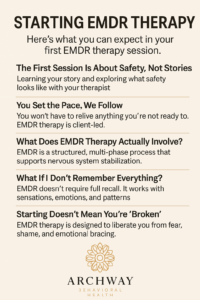You’re Here. That’s Enough.
The day you make your first therapy appointment doesn’t always feel brave. Sometimes it feels terrifying. You might think, “What if I can’t do this?” Or, “What if it makes things worse?”
If you’re newly diagnosed with trauma, PTSD, anxiety, or another mental health condition, the thought of starting EMDR therapy might feel like stepping into a fog with no map.
Let’s clear that fog together.
Because no matter what you’ve been through, your first EMDR therapy session isn’t about diving in headfirst. It’s about slowly opening a door—and knowing you don’t have to walk through it alone.
The First Session Is About Safety, Not Stories
At Archway Behavioral Health in Boca Raton, we don’t rush healing. Your first EMDR therapy session won’t be about processing trauma. It’s about understanding you.
Here’s what we’ll focus on:
- Learning your story and what brings you in
- Understanding your emotional and physical reactions to stress
- Exploring your goals and hopes for therapy
- Getting curious about what safety looks like for you
You don’t need to know all the answers. You just need to show up with curiosity—and maybe a little courage.
You Set the Pace. We Follow.
One of the biggest myths about EMDR is that it forces people to relive their worst moments. The truth is the opposite.
EMDR therapy is client-led. You won’t be pushed to share more than you want to. You can pause anytime. You can slow things down. And if something doesn’t feel right, your therapist will listen.
This is your healing. We’re just walking beside you.
What Does EMDR Therapy Actually Involve?
You may have heard EMDR described as “tapping” or “eye movement therapy.” That’s part of it—but it’s much more than a technique.
EMDR stands for Eye Movement Desensitization and Reprocessing. It’s a structured method that helps your brain reprocess traumatic memories that have been stuck in fight, flight, or freeze mode.
Here’s how the overall process works:
- History Taking & Preparation (sessions 1–3): You’ll build rapport, identify goals, and practice calming techniques.
- Assessment: Together, you and your therapist will identify specific memories or patterns to target—when you’re ready.
- Reprocessing: This is where the eye movements or tapping begin, helping the brain integrate what was never fully processed.
- Installation & Body Scan: Positive beliefs are reinforced and checked somatically.
- Closure & Reevaluation: You’ll return to calm, review progress, and decide next steps.
Most first sessions focus entirely on Step 1: building safety, comfort, and trust.
What If I Don’t Remember Everything?
Many clients worry that they’ll have to dredge up memories they can’t fully recall—or talk about things they’ve never said out loud.
EMDR doesn’t require perfect memory. It works with fragments, body sensations, emotions, and patterns. Sometimes healing happens without needing words at all.
And no, you don’t need to talk through every detail. Often, it’s enough to hold a memory or feeling loosely in your awareness while your brain does the work in the background.

Starting Doesn’t Mean You’re “Broken”
Many newly diagnosed clients feel shame for even needing therapy. They say things like:
- “Other people had it worse.”
- “I should be able to handle this.”
- “I don’t want to be defined by my trauma.”
EMDR is not about labeling you. It’s about liberating you. From fear, from shame, from the constant state of emotional bracing that so many people live with without realizing it.
Your brain is doing its best to protect you. EMDR simply helps it rest.
A Client Story: From Panic to Possibility
A woman came to us from Delray Beach after years of quiet panic. On the outside, she looked put together. But internally, she was overwhelmed by memories that had no clear timeline—just a steady hum of dread.
She was terrified to start therapy, convinced she’d fall apart. But her first EMDR session didn’t involve any trauma processing. It was just talking. Naming fears. Practicing grounding. Building safety.
By the third session, she said something we never forgot:
“I thought therapy would break me open. I didn’t expect it to make me feel stronger.”
That’s the power of pacing—and of EMDR done right.
FAQ: EMDR Therapy for the Newly Diagnosed
Do I have to relive my trauma in EMDR?
No. EMDR is not about reliving. It’s about reprocessing. You’ll revisit feelings and images—but with enough safety and distance that your brain can integrate them without overwhelm.
What if I shut down or dissociate during therapy?
That’s okay. Your therapist is trained to notice the signs and help you stay grounded. You’ll also learn tools to bring yourself back to the present gently and effectively.
How soon will we start reprocessing traumatic memories?
Not right away. Most people spend 1–3 sessions (or more) building safety and practicing stabilization before any reprocessing happens.
Can EMDR work if I don’t remember the trauma clearly?
Yes. EMDR works with what’s available—sensations, emotions, beliefs—not just vivid memories. The brain has many ways of storing and healing trauma.
Is EMDR helpful even if my trauma doesn’t feel “big”?
Absolutely. Emotional neglect, bullying, complicated relationships, and chronic stress are all valid—and treatable—sources of trauma.
You Don’t Need to Be Ready. You Just Need to Be Willing.
Starting EMDR therapy is like dipping your toes into the water of healing. You don’t have to swim on day one. You just need to feel the water and decide if it’s safe enough to step in.
At Archway Behavioral Health, we specialize in trauma-informed care that honors your pace, your fears, and your hope. If you’re in Deerfield Beach, Coral Springs, or Boca Raton, you’re already closer to healing than you think.
Looking for EMDR therapy in Coral Springs, Florida? Our Boca Raton center offers a welcoming space designed to help you begin therapy without pressure.
Let Your Healing Start Gently
Call (888) 530-0227 to learn more about our EMDR therapy services in Boca Raton, Florida.


